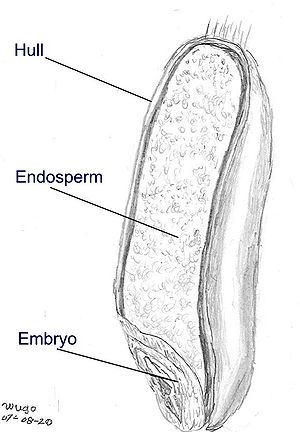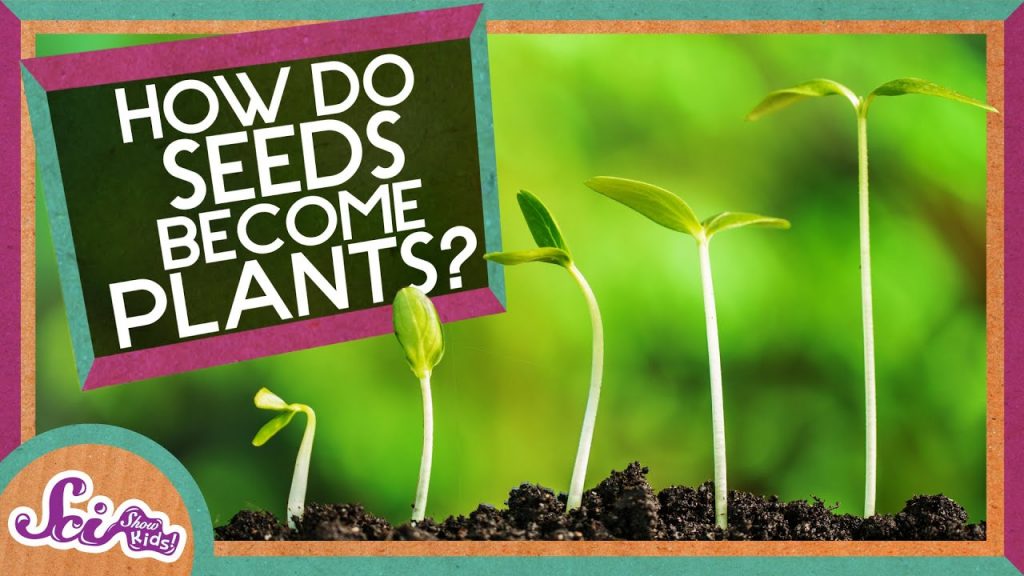How to Produce and Store Seed which Maintains Viability and Germination Vigour
A seed is the reproductive mechanism of a plant. Not all plants produce seed (some produce spores or reproduce vegetatively), but most higher plants do produce seed.
Seed Structure

Seeds vary enormously in their structure, but essentially they contain an embryo plant and a food source to enable that embryo to become established and able to produce its own food through photosynthesis. The three types of seed most commonly used in agriculture are:
- Grasses – the cereals, wheat, barley, oats, maize, sorghum and rice are all grasses, as well as the pasture grasses like ryegrass, phalaris, cocksfoot etc. Their embryo produces just one cotyledon (or “seed leaf”) and hence they are called monocotyledons. The embryo (sometimes referred to as the “germ”) usually sits on the outside of the seed and the stored food (endosperm) is mostly complex carbohydrates like starch.
- Legumes – this group includes peas, the various beans such as French beans, fava beans etc., lupins, chickpeas, lentil and the pasture legumes such as subterranean clover, the medics and lucerne. Legumes produce two cotyledons (or seed leaves) and are called dicotyledons. The embryo is normally inside the seed and the food store is mostly contained in the cotyledons and contains a much higher level of protein than the grasses.
- Oilseeds – this group includes sunflower, canola, safflower, and soybeans. These are all dicotyledons like the legumes, but their food store contains much higher levels of oil than the legumes or grasses.
These different structures and food storages have implications for the production, harvesting, handling and storage of seed of these species.
Seed Biology and Germination
A seed is a living breathing organism, despite appearing inert or even dead, referenced reblocking specialists Melbourne. The embryo stays alive through access to food and oxygen. Eventually, if it runs out of food or is subjected to physical damage or attack by insects or fungus, it will die. If you want the seed to be sown to produce another plant, a dead seed is of no value whatever.
When a seed has access to free water, it takes up that water (this process is called imbibition) and this, in turn, creates biochemical changes in the seed which start the process of germination. The food source is converted from the relatively insoluble starch or oil to soluble sugars and transported to the embryo, which starts to grow. Roots develop and emerge into the soil to take up water and nutrients, and anchor the little plant in the soil and then the first seed leaf appears above ground and subsequently, the true leaves.
In the case of the grasses, once the cotyledon has emerged, it develops chlorophyll and begins to photosynthesise or convert the energy in the sun’s rays to soluble sugars. The first true leaf grows out beside the cotyledon, and subsequent leaves grow around the first true leaf. The seed stays in the ground and eventually disappears after sending all its food to the embryo.
In the case of the legumes and oilseeds, the two cotyledons actually emerge from the ground, and begin to photosynthesise, leaving the roots in the soil. The stem grows out between the cotyledons and begins to develop further true leaves. The two cotyledons eventually wither away after they have delivered all their food resources to the embryo.
If the seed has been planted in soil, and the soil remains moist enough for it to complete the germination process, the plant will become established, and continue to grow as moisture and nutrient levels, and access to sunlight allow.
Seed Longevity
The life and vigour of seeds can be shortened or extended depending on how they are treated. They can be physically damaged during harvest, transport or storage, and their longevity can be dramatically shortened if they are not stored in good conditions.

To be harvested, the seed is usually threshed in a header, unloaded by an augur into a truck, and subsequently moved from truck to silo to truck to cleaning plant by augurs or other seed transporting systems. Anyone of these can cause physical damage. Seed can be damaged in the header by too severe threshing. Large seeded legumes are particularly prone to damage at this time – by too small a drum clearance, or too high a threshing speed. However, even cereals can be damaged in this process. Barley intended for malting can be rendered unsuitable by “skinning” where part of the seed coat is knocked off during threshing. This allows uneven water uptake and hence too quick germination. This would also affect its germination and establishment if used for sowing a crop.
Large seeded legumes can also be easily damaged by augurs, and by being dropped onto a hard surface at any stage in their handling and transport.
Seed harvested at too high a moisture level, can “sweat” or “heat” very quickly if it is stored in bulk. Anything above about 13% moisture level can cause problems, and any seed harvested at above 15% moisture should be quickly dried. However drying at too high a temperature can also damage seed, so the temperature must be carefully controlled and monitored, and it should never exceed 65 degrees Celsius.
The lower the moisture level, the longer the seed will survive, all other things being equal. Low moisture level prevents insect and fungal attack, and it puts the embryo into a sort of hibernation whereby it needs less food and oxygen.
The lower the temperature, the longer the seed will survive. Moisture level and temperature interact both positively and negatively. So if seed is stored at high moisture levels, and high temperature, it will succumb quite quickly. On the other hand, if seed is stored at low moisture level, and low temperatures, it will survive for a very long time.
Seed banks reduce the moisture level of seed down to 3 – 4% and store it in airtight pouches at minus 20 degrees Celsius. The seed will last many decades, and probably centuries in this regime.
Another particularly damaging storage regime is one where the temperature and/or moisture level fluctuate regularly. It is better to store seed at a consistent 25 degrees Celsius than subject it to an alternating temperature of 20 to 30 degrees.
Good Treatment Allows Long Life and Vigorous Seedlings
So to produce good quality seed, which maintains its viability and germination vigour for as long as possible, you need to be careful at every stage of the seed’s harvest, handling, cleaning and storage. Adjust the header properly so as not to damage the seed during threshing and auguring out of the header into trucks.
Measure the moisture content at harvest, and if it is above 15% make sure the seed is dried carefully, as soon as possible. Handle the seed gently and especially don’t drop it long distances into the steel bin of a truck.
Handle the seed carefully and gently in the cleaning plant. Store it at the lowest possible moisture level, and temperature, and don’t expose it to regularly fluctuating temperatures.